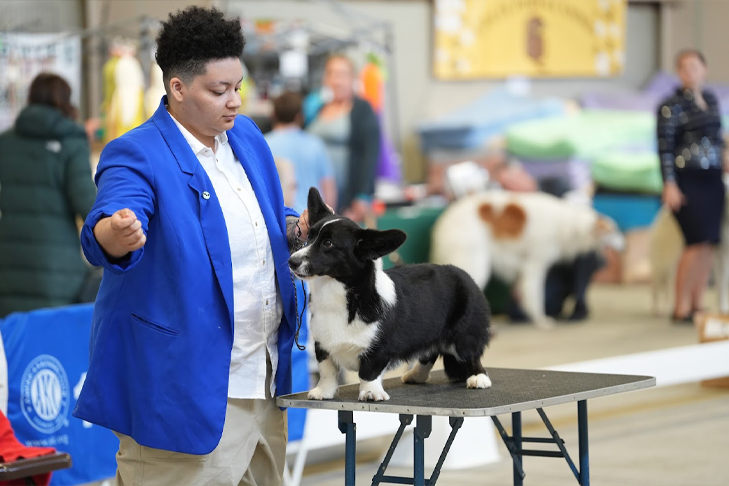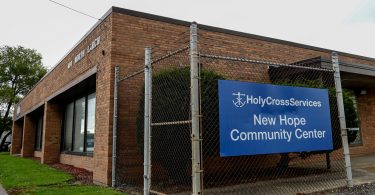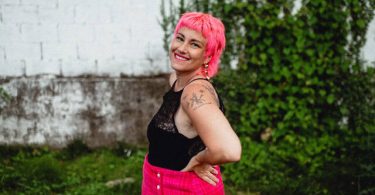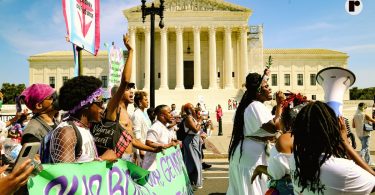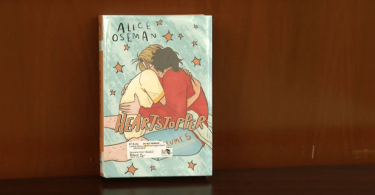Celebrating the diversity of our dog sports community helps our sports thrive and make everyone feel welcome. I first came out as queer in the 1990s. I was a Junior Handler competing in Agility into the early 2000s and experienced a lot of homophobia. Thankfully, over the last 20 years, there have been significant cultural shifts in society the dog community has become more inclusive and welcoming of diversity.
When we talk about the importance of being welcoming and inclusive of LGBTQ+ people at dog shows, sometimes people respond by saying someone’s gender identity or sexual orientation “shouldn’t matter” in dog sports, or that they are “just here for the dogs.” We all love dogs, but we should also care about respecting the people on the other end of the leash. Doing this makes our dog community stronger and more welcoming. For Pride month, I spoke with other LGBTQ+-identifying competitors to learn about what being out at dog shows means to them.
Why Being Out at Dog Events Matters
Theresa Hineline
Ethaniel Raymond Mick is a bisexual, transgender man who competes in Conformation, AKC Fast CAT, Herding, AKC Trick Dog, and AKC Scent Work with his Cardigan Welsh Corgis. For Mick, being out is about being his best and true self. By being more welcoming of diversity, more people will feel welcome to get involved in dog sports. For many LGBTQ+ competitors, being out isn’t just about wanting people to know who we are, but it’s about making space for other people who might not be out yet, or LGBTQ+ dog lovers who may be worried about how they’ll be treated at dog shows.
This was especially true for Sarah Forde, who identifies as bisexual. “I grew up in a community and environment that had essentially zero queer representation,” she explains. “Being able to be myself and connect with people like me in the dog sport world has helped me feel safe and comfortable, and learn who I am.” Forde primarily competes in Agility, but has also titled dogs in AKC Rally, Obedience, Barn Hunt, Diving Dogs, and AKC Trick Dog.
Brianne Elizabeth Farr, who is pansexual, is an active competitor in Obedience, AKC Rally, Agility, Conformation, Herding, Coursing, and Fast CAT. Farr, who also won the AKC Rally National Championship in 2020, explains that she perceived being out in the dog world as something of a badge of honor. “I remember growing up in the dog community and I would notice older dog people that were living their lives out and proud as queer people, and they were always such a big inspiration for me,” she says. “I thought to myself, ‘If they can do it, I can too.’ I want to be that inspiration for the next generation of queer dog folks.”
Positive Experiences Being Out at Dog Events
Being out as part of the LGBTQ+ community takes courage. “Jumping into the world of dog sports was a bit terrifying, especially in the South. I had no idea what to expect,” explains Kayla Crump, who participates in AKC Lure Coursing, CAT, Fast CAT, Conformation, and is currently in the process of becoming an AKC Lure Coursing Judge. “I spent my first two years in dog sports trying to gauge who it was safe to be out to and open with.” For Crump, emerging from the COVID-19 lockdowns was the inspiration to be fully themself everywhere, including the dog world. “When things started up again in late 2020, I had decided that I was going to just be myself and if anyone had issues with that, that’s their problem to deal with.” It turns out, the dog community was more welcoming than they had imagined!
It’s never anyone’s responsibility to educate people about the details of their life or identity. But, for those of us who feel comfortable doing this kind of community education, it can make a difference in helping people to better understand who LGBTQ+ dog people are. Last year, I was an invited speaker at the Association of Professional Dog Trainers’ National Conference in Covington, Kentucky, and taught a session on “LGBTQ+ 101 for Dog Trainers.” Helping dog trainers understand the basics of LGBTQ+ identity, so they can be more inclusive to clients is one of my favorite aspects of the work that I do.
Katie Cecilio, who identifies as queer and competes in Conformation, Fast CAT, CAT, and Barn Hunt with their Bedlington Terriers also feels strongly about helping to educate other dog people about the LGBTQ+ community. “I have established myself as someone who is open to questions and providing education regarding LGBTQ+ issues among my dog show friends and family,” they said. Being available to answer questions can help allies feel less nervous about getting something wrong and help foster more open communication and understanding.
Although LGBTQ+-identifying people may worry that they’ll face discrimination at dog shows if they come out, that often isn’t the case anymore. In fact, many of us have found support and inclusivity within the dog community. For Crump, a special moment of belonging happened while lure coursing at the Ibizan Hound National Specialty. “For the very first time, a total stranger asked for my pronouns, unprompted. I was honestly so shocked,” they said. This experience was meaningful for Crump because it was the first time someone hadn’t just assumed their pronouns, and it meant they didn’t get misgendered. “It was a bit of a euphoric moment to be recognized in that sort of way,” they recall. These kinds of positive experiences were echoed by Farr. “I’ve been very pleasantly surprised with the amount of support and love I have felt from straight allies in the dog community,” they said. “There are always going to be some people who say or do unkind things, but I’ve been met with primarily overwhelming support from the AKC dog sport community.”
Photo by Pix ‘n Pages ©AKC
Creating Inclusive Spaces in Dog Sports
A core reason many LGBTQ+ people are increasingly choosing to be out in the dog world is to make the community safer for others. While nobody should ever be forced to be out, those of us who feel comfortable being our authentic selves in the dog world can help make events feel safer for everyone. “Being visibly out and queer, I hope I can help even one person who is new to lure coursing or dog sports, in general, feel safer about being themselves and being in that kind of environment with people they don’t know,” Crump explained. They admitted that being out hasn’t always felt so easy, and in their first few years involved in dog sports they worried about how safe they really were. Those memories inspire them to be out now. “I want to prevent that worry and that feeling of unease in those that come after me. To keep these sports alive for the next generations, we need to be open and inclusive and welcoming of people from all walks of life and of all identities and I hope to be a part of that,” they explained.
Being visibly and openly queer also can mean being visible to the next generation of dog sports competitors. “Juniors and new dog owners considering getting into sports reach out to me with questions specifically because I am very openly queer. It’s always extra exciting to see where they go in their training and competition journeys,” explains Forde. I’ve had similar experiences, and knowing that my queer presence has in some small way made other LGBTQ+ people feel safer or more welcome at an event is extremely rewarding. Mick explained that at dog shows his “favorite part of being out, loud and proud, is attracting other like-minded individuals!” He adds, “People feel safe around my friends and I and we can enjoy our company regardless of what we show or participate in. We’re there for us!”
LGBTQ+ Dog People Are Everywhere
Those of us who can be out, and who choose to be out, help to foster a more inclusive dog community. “I’m so lucky that I am able to be out and proud safely,” says Cecilio. “I try to use that to uplift other members of the LGBTQ+ community in the dog world. The more we are unapologetically visible, the more our presence is normalized and eventually accepted.” Although we are everywhere, it’s not always easy to find the confidence to be out. “Being out and visibly LGBTQ+ is a huge leap of faith in your fellow enthusiasts, but ultimately you have to give people the chance to show you who they are,” adds Crump. “There is a risk for negative experiences, I’ve had plenty by just living in the rural south and looking like I do, and things are not perfect by any means. But I think in general you’re going to find a bigger support network than you realized existed.”
Beyond the expectation of good sportsmanship, there is a growing desire to make our dog sports communities more inclusive. “If you are reading this as a member of the LGBTQ+ community, don’t be afraid to make your voice heard. Just one out and proud voice can make a huge impact on other people within these two communities,” encourages Farr. It brings me so much joy to be out in dog sports, and it’s my deepest hope that those of us who can be out can help make dog shows, training classes, and the dog fancy more welcoming and inclusive.

